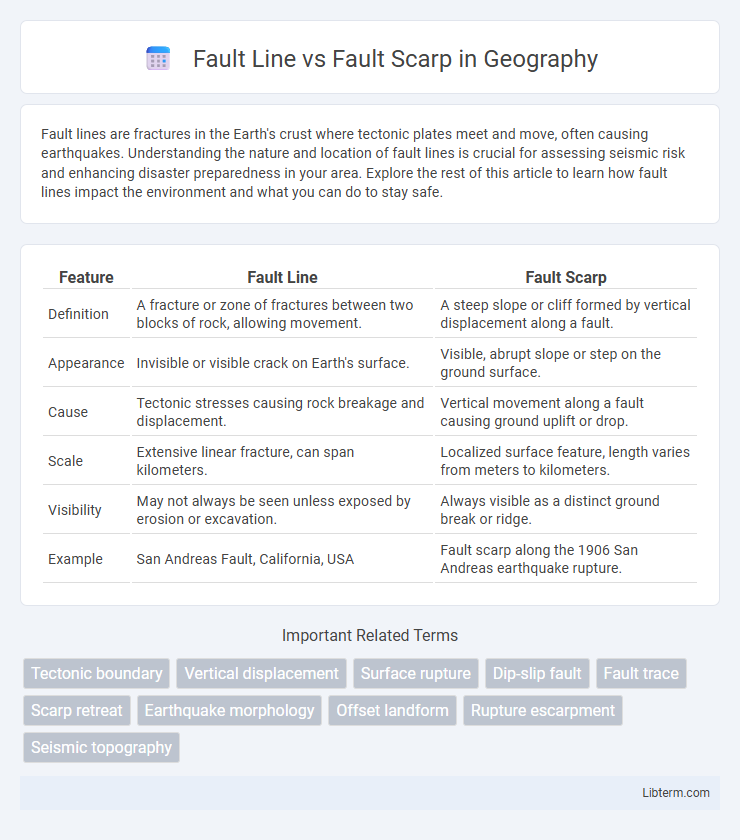Fault lines are fractures in the Earth's crust where tectonic plates meet and move, often causing earthquakes. Understanding the nature and location of fault lines is crucial for assessing seismic risk and enhancing disaster preparedness in your area. Explore the rest of this article to learn how fault lines impact the environment and what you can do to stay safe.
Table of Comparison
| Feature | Fault Line | Fault Scarp |
|---|---|---|
| Definition | A fracture or zone of fractures between two blocks of rock, allowing movement. | A steep slope or cliff formed by vertical displacement along a fault. |
| Appearance | Invisible or visible crack on Earth's surface. | Visible, abrupt slope or step on the ground surface. |
| Cause | Tectonic stresses causing rock breakage and displacement. | Vertical movement along a fault causing ground uplift or drop. |
| Scale | Extensive linear fracture, can span kilometers. | Localized surface feature, length varies from meters to kilometers. |
| Visibility | May not always be seen unless exposed by erosion or excavation. | Always visible as a distinct ground break or ridge. |
| Example | San Andreas Fault, California, USA | Fault scarp along the 1906 San Andreas earthquake rupture. |
Introduction to Fault Lines and Fault Scarps
Fault lines are fractures in the Earth's crust where tectonic plates meet and move, causing earthquakes and seismic activity. Fault scarps are the visible, steep cliffs or slopes formed on the ground surface when movement along a fault displaces the land vertically. Understanding fault lines and their associated fault scarps is crucial for assessing seismic hazards and geological landscape changes.
Defining Fault Lines
Fault lines are fractures in the Earth's crust where tectonic plates or rock masses have moved relative to each other, often causing earthquakes. These linear zones represent the surface traces of fault planes beneath the ground, marking significant geological boundaries. Fault scarps, by contrast, are the visible, steep slopes or cliffs formed by vertical displacement along a fault line, providing a physical indication of past seismic activity.
What is a Fault Scarp?
A fault scarp is a visible, steep slope or cliff formed directly by the vertical displacement along a fault during an earthquake. It represents the exposed surface where the earth's crust has broken and shifted, often resulting in a sharp, linear feature on the landscape. Unlike a fault line, which is the subsurface fracture itself, a fault scarp is the topographic expression of that displacement.
Geological Processes Behind Fault Lines
Fault lines represent the fractures in the Earth's crust where tectonic plates meet and move, causing seismic activity and crustal deformation. Fault scarps form as visible, steep cliffs along fault lines due to vertical displacement during earthquakes or gradual slip along the fault plane. The geological processes behind fault lines involve stress accumulation, rock rupture, and displacement, leading to landform changes and seismic hazard zones.
How Fault Scarps Form
Fault scarps form as a visible landform created when there is a vertical displacement along a fault line during an earthquake. The movement along the fault line causes one side to be uplifted or dropped relative to the other, producing a steep slope or cliff known as a fault scarp. The height and shape of the fault scarp depend on the amount of displacement and the geological materials involved.
Key Differences Between Fault Lines and Fault Scarps
Fault lines are fractures in the Earth's crust where tectonic plates or rock masses have moved, often extending for many kilometers and representing zones of seismic activity. Fault scarps are the visible, steep slopes or cliffs formed on the Earth's surface directly above a fault line due to vertical displacement during an earthquake. The key difference lies in fault lines being subsurface fractures, while fault scarps are the surface expressions of these faults caused by recent tectonic movements.
Visual Identification in the Field
Fault lines appear as linear zones of crushed and displaced rock often marked by a noticeable break or shift in the landscape, while fault scarps are distinct, step-like landforms created by vertical displacement along a fault. In the field, fault scarps are characterized by sharp, elevated edges or cliffs that reveal exposed fault surfaces, making them more visually prominent than fault lines. Vegetation patterns and soil accumulation differences along the fault scarp further aid in visual identification during field surveys.
Significance in Earthquake Studies
A fault line represents the invisible fracture along which tectonic plates or rock masses have moved, serving as a critical indicator of seismic activity potential in earthquake studies. The fault scarp, a visible surface feature formed by vertical displacement during an earthquake, provides tangible evidence of past seismic events and helps quantify slip magnitude and earthquake recurrence intervals. Understanding the relationship between fault lines and fault scarps enhances seismic hazard assessments and informs earthquake preparedness strategies.
Notable Examples Worldwide
The San Andreas Fault in California is a prominent fault line known for its seismic activity, while the related fault scarp of Calico Mountains showcases visible ground displacement from past earthquakes. The Dead Sea Transform fault line in the Middle East corresponds with rugged fault scarps along the Jordan Rift Valley, marking tectonic plate boundaries. In New Zealand, the Alpine Fault's massive fault scarp is a key feature illustrating active lateral displacement between the Pacific and Australian plates.
Conclusion: Understanding Fault Structures
Fault lines represent the fracture zones where tectonic plates or rock masses have slipped, often extending deep beneath the Earth's surface. Fault scarps are the visible, above-ground expressions of these movements, characterized by steep slopes or cliffs formed by displacement during seismic events. Recognizing the distinction between fault lines and fault scarps is crucial for accurately assessing earthquake hazards and geological stability.
Fault Line Infographic

 libterm.com
libterm.com